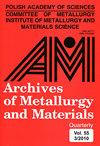冲天炉炉渣与高炉炉渣的比较及其利用可能性
IF 0.7
4区 材料科学
Q4 METALLURGY & METALLURGICAL ENGINEERING
引用次数: 10
摘要
本文章由计算机程序翻译,如有差异,请以英文原文为准。
Comparison of Cupola Furnace and Blast Furnace Slags with Respect to Possibilities of Their Utilization
Blast furnace and cupola furnace are furnace aggregates used for pig iron and cast iron production. Both furnace aggregates work on very similar principles: they use coke as the fuel, charge goes from the top to down, the gases flow against it, etc. Their construction is very similar (cupola furnace is usually much smaller) and the structures of pig iron and cast iron are very similar too. Small differences between cast iron and pig iron are only in carbon and silicon content. The slags from blast furnace and cupola furnace are very similar in chemical composition, but blast furnace slag has a very widespread use in civil engineering, primarily in road construction, concrete and cement production, and in other industries, but the cupola furnace slag utilization is minimal. The contribution analyzes identical and different properties of both kinds of slags, and attempts to explain the differences in their uses. They are compared by the contribution of the blast furnace slag cooled in water and on air, and cupola furnace slag cooled on air and granulated in water. Their chemical composition, basicity, hydraulicity, melting temperature and surface were compared to explain the differences in their utilization.
求助全文
通过发布文献求助,成功后即可免费获取论文全文。
去求助
来源期刊

Archives of Metallurgy and Materials
工程技术-冶金工程
CiteScore
1.20
自引率
0.00%
发文量
0
审稿时长
4.5 months
期刊介绍:
The Archives of Metallurgy and Materials is covered in the following Institute for Scientific Information products: SciSearch (the Science Citation Index - Expanded), Research Alert, Materials Science Citation Index, and Current Contents / Engineering, Computing and Technology.
Articles published in the Archives of Metallurgy and Materials are also indexed or abstracted by Cambridge Scientific Abstracts.
 求助内容:
求助内容: 应助结果提醒方式:
应助结果提醒方式:


